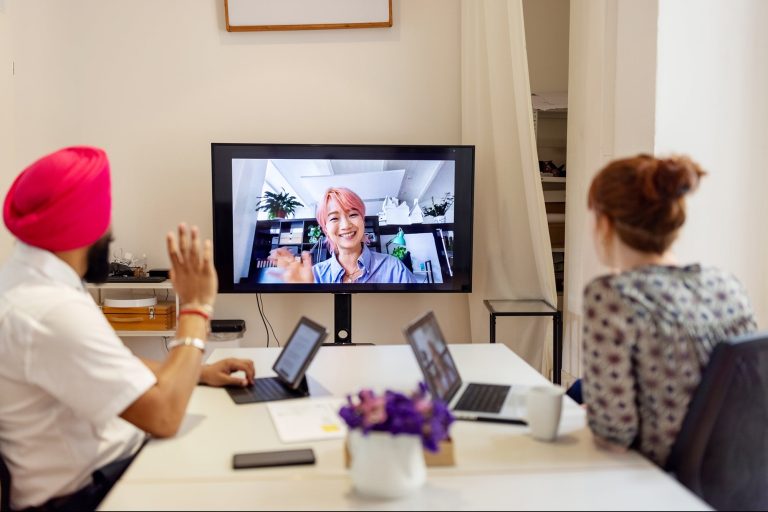Entrepreneur
A new study by Logitech of 3,000 employees and 1,000 IT hardware decision-makers in large organizations found that 89% struggle with video and 85% with audio in their work-from-home office. Less than 40% received accessories other than mice and keyboards from their organizations.
While these results are concerning, I didn’t find them surprising. When working with client organizations to help them figure out the best hybrid work arrangements, I invariably get pushback when I bring up investing in hybrid worker home offices. CFOs don’t want to “waste” money on employee home offices after already paying for a set-up at the office; in turn, IT and facilities directors express reluctance to stretch their already-thin resources to support the tech and ergonomic needs of staff working from home.
After all, these leaders say, we already gave in to employee demands for flexibility and allowed them to work from home part of the time. They can pay for their own equipment and furniture.
Related: They Say Remote Work Is Bad For Employees, But Most Research Suggests Otherwise — A Behavioral Economist Explains.
The reality of work from home office setups for hybrid employees
In reality, the large majority of workers don’t pay to equip their home offices. When I ask about this issue in focus groups for my clients, employees tell me it’s the company’s job to fund their work-from-home needs. They feel it would be unfair for them to buy whatever they need for their home office just for the sake of doing work for the company. Indeed, in a survey I ran on LinkedIn with over 200 respondents, over two-thirds of respondents believe companies should cover the costs of equipment.
So they end up struggling with technology and ergonomic challenges. Doing so harms their productivity since they can’t work as effectively. It undermines their wellbeing, due to physical discomfort from lack of ergonomic furniture and mental discomfort from concerns about how they appear on camera. It undercuts retention because employees feel frustrated and resentful over not having the equipment they need to do their job well.
And it hurts their collaboration and communication: poor video and audio quality are a bigger problem for those the employee is communicating with rather than for the employee themselves. That involves other employees, but also external stakeholders, such as clients, vendors and investors.
Related: Avoid These 3 Tempting Habits For Remote Work Productivity
All of that harms a company’s bottom lines: as I tell leaders with whom I work, do they really want to lose a sale because they didn’t get a good microphone for their sales staff? That’s not an exaggeration: the Logitech study found that 37% of respondents hold video calls with clients.
With 79% of companies switching to a hybrid work modality, according to the EY Work Reimagined Employer Survey, a large portion of the work employees do for a company will be done from home offices going forward. Given that, I tell my clients that it’s imperative to invest in equipping staff for work from home.
Logitech insights on challenges and opportunities for the work-from-home office
To find out more about the challenges and opportunities of equipping hybrid workers, I interviewed Simon Dudley, Head of Analyst Relations at Logitech, about the release of their study. He told me that Logitech discovered a common experience among most survey respondents.
At the start of the pandemic, companies told staff to grab whatever they could from the office in the transition to remote work. And that’s what staff mostly ended up using for their home office, along with whatever additional equipment more tech-savvy staff had at home or, in some instances, chose to buy online. IT departments adopted a reactive posture: as Dudley stated, “IT departments sit there and basically wait for the phone to ring for someone to complain, at which point they go and try and fix that problem.” The problem with that posture? Most staff members “don’t even know what they could do to make their life better. But they do know what they’ve got today isn’t great.”
The Logitech study confirms employee concerns: 64% struggle with poor or inadequate light in their homes; 60% have poor sound quality through computer speakers; and 58% need to sit in an uncomfortable position to be on camera. They waste valuable work time figuring out technology: 53% check if their speakers and microphone are working, 41% fiddle with the viewing angle of their camera, and so on.
Yet staff don’t feel it’s right or fair for them to purchase better equipment and furniture themselves, and don’t feel empowered to reach out to IT or facilities to fix these problems. As Dudley said “the users are like, well, I assume this is the best that’s available. I mean, they’ve given me a laptop. I’ve got all the things, how can I say to the IT department, I want better when they don’t even know better exists?”
Of course, it’s not only IT and facilities that need to step up. Dudley pointed out that HR needs to get involved. After all, they are responsible for talent management. Optimizing employee productivity, wellbeing and collaboration through support for worker home offices should be a major concern for them. Dudley told me that it’s simple: just go to HR and ask them “how much does it cost you when your workers are off sick with RSI issues or with eye strain or with migraines.” By comparison, the cost of equipping a home office is small, and this wellbeing benefit doesn’t account for boosted productivity and collaboration.
Related: Malcolm Gladwell’s Fears About Remote Work Are Real. It’s Your Brain That’s Telling You Lies — Here’s Why.
Work from home office funding: A case study
Then, I asked Dudley to give feedback on how I helped my consulting clients determine how to support the home offices of their workers, using the example of the University of Southern California’s Information Sciences Institute.
First, we surveyed staff to determine their needs and concerns regarding technology and furniture, focusing on how we can help them be more productive and have better ergonomics and wellbeing. We encouraged employees to volunteer any suggestions on specific technology and furniture solutions they found to be a good fit for their needs. We also had the Institute’s IT and facilities staff conduct in-depth research on market options based on survey results.
Then, we determined an initial list of standardized equipment that IT and facilities felt comfortable they could support in employee home offices. We shared the list with staff members in another survey and revised it based on their responses.
Next, we purchased equipment for staff members and shipped it to their homes. For anyone who needed help with the equipment, we arranged for home visits by IT and facilities staff. To address tax concerns, we developed a policy asking staff members leaving the organization to donate any bulky furniture that was impractical to return to facilities. Finally, we covered the costs of fast broadband for staff.
Dudley applauded this approach as exemplary. He did highlight that sometimes staff don’t know what they need because they may not be aware of relevant capabilities, and thus encouraged providing more hands-on guidance and expertise. I integrated that approach into my work with future clients.
Conclusion
In short, failing to invest in hybrid worker home offices is penny-wise, but pound-foolish. We know that much if not most of the work done by staff members for the large majority of companies going forward will be from home offices. And most employees won’t buy quality tech and furniture: they feel it’s not fair to ask them to do so. Companies that fail to invest in home offices will lose out on productivity, wellbeing, retention, collaboration and communication, all of which will reflect poorly on their bottom lines.
Read the full article here









